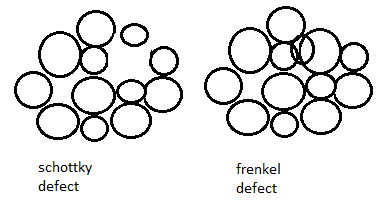⬅️Previous:The Solid State : NCERT Exercise Based MCQs (1 to 4/13 Qs) [Difficult level:Easy]
.Nickel oxide has the formula Ni0.98O1.00. The fraction of nickel existing as Ni3+ ions will be -
1. 0.041
2. 0.959
3. 0.736
4. 0.264
.
⬆️Prev____@organised notes_____Next⬇️
.A ferric oxide crystallizes in a hexagonal close-packed array of oxide ions with two out of every three octahedral holes occupied by ferric ions. The formula of the ferric oxide is-
1. FeO
2. Fe2O3
3. Fe3O4
4. Fe3O2
.
.
⬆️Prev____@organised notes_____Next⬇️
.A compound is formed by two elements M and N. The element N forms ccp and atoms of M occupy 1/3rd of tetrahedral voids. The formula of the compound would be -
1. MN
2. M3N4
3. M2N3
4. M3N2
.
.
⬆️Prev____@organised notes_____Next⬇️
.An element with a molar mass of 2.7 × 10-2 kg mol-1 and density 2.7 × 103 kg m-3 forms
a unit cell with an edge length of 405 pm. The type of unit cell is-
1. Simple cubic cell.
2. Face centered cubic cell.
3. Body-centered cubic cell.
4. None of the above.
.
.
⬆️Prev____@organised notes_____Next⬇️
.The similarity between metallic and ionic crystals is -
1. Both these crystal types are held by the electrostatic force of attraction.
2. Both these crystal types are held by the Van der Waal's forces of attraction.
3. Both these crystal types are held by hydrogen bonding .
4. Both these crystal types are held by covalent bonding.
.
.
Answer ▽ ✅Verified
1. Both these crystal types are held by the electrostatic force of attraction.
The basis of similarities and differences between metallic and ionic crystals are given below:
Similarities: Both ionic and metallic crystals have electrostatic attractive forces. In ionic crystals, the forces are present between oppositely charged ions and in metallic crystals; the forces are between valence electrons and kernels. Due to this, both crystals have high melting points. Both crystals have non directional bonds.
Differences: Ionic crystals do not conduct electricity in solid state as ions are not free to move. They conduct electricity in molten states and in aqueous solutions. Molecular crystals conduct electricity in solid state as valence electrons are free to move.
Ionic bonds in ionic crystals are strong due to electrostatic attractive forces. However, in metallic crystals, the metallic bond may be weak or strong depending upon the number of valence electrons and the size of the kernels.
Ionic solids are hard due to the presence of strong electrostatic attractive forces among oppositely charged ions. Due to the non directional nature of ionic bonds, the ionic solids are brittle.
⬆️Prev____@organised notes_____Next⬇️
.Higher conductivity of p-type and n-type semiconductors is due to :
1. Increase in the number of positive holes and mobile electrons respectively .
2. Increase in the number of electrons in both types of semiconductors.
3. Increase in the number of positive-holes in both types of semiconductors.
4. None of the above.
.
.
Answer ▽ ✅Verified
1. Increase in the number of positive holes and mobile electrons respectively .
⬆️Prev____@organised notes_____Next⬇️
.NaCl is doped with 10−3 mol % of SrCl2, the number of cation vacancies post doping would be -
1. 4.022 × 108
2. 5.022 × 1018
3. 6.022 × 1018
4. 7.022 × 108
.
.
⬆️Prev____@organised notes_____Next⬇️
.The relation between the atomic mass of unknown metal with density and the dimension of its unit cell is given by :
(Givne: All the cell edge lengths are equal)
1.
2.
4.
.
.
⬆️Prev____@organised notes_____Next⬇️
.The correct statement among the following is:
1. Semiconductors have a small energy gap between the valence band and the conduction band.
2. Conductors have overlapped valence band and conduction band.
3. Insulators have a large energy gap between the valence band and conduction band.
4. All of the above.
.
.
Answer ▽ ✅Verified
4. All of the above.
⬆️Prev____@organised notes_____Next⬇️
.A defect that has an equal number of missing cations and anions is:
1.Schottky defect.
2. Frenkel defect.
3. Both (1) and (2)
4. None of the above.
.
.
Answer ▽ ✅Verified
1.Schottky defect.
The diagrammatic representation for schottky defect and frenkel defect is as shown below:

⬆️Prev____@organised notes____End








